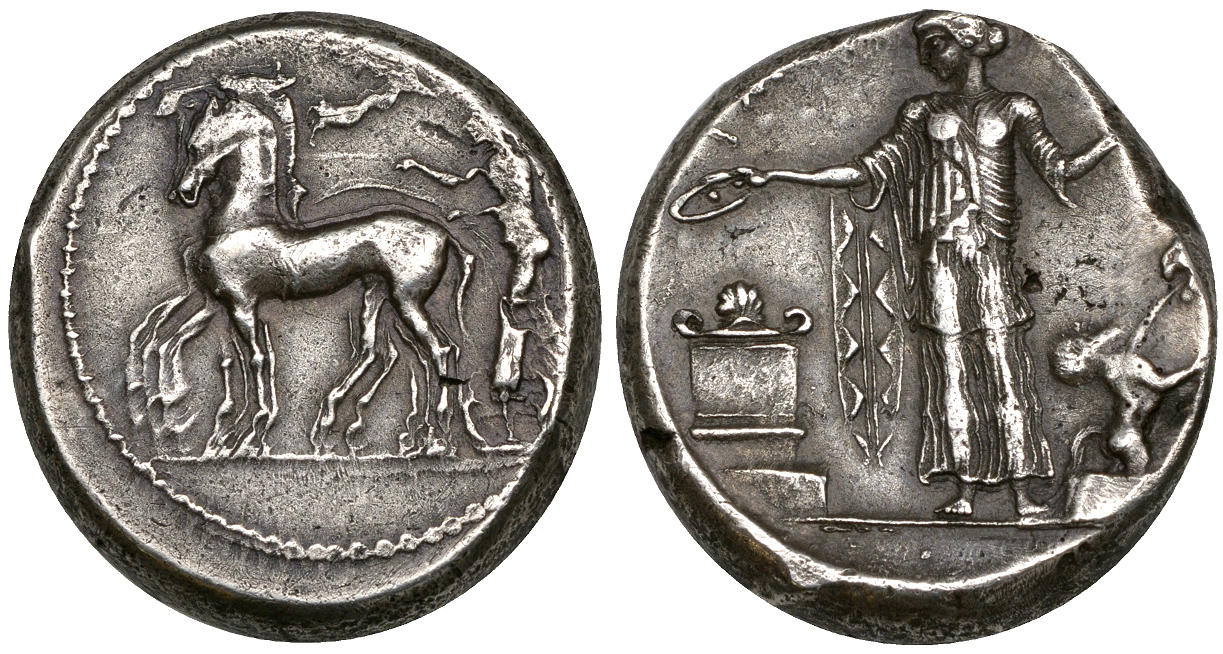Himera, silver, tetradrachms (Himera driving biga/standing Himera holding patera) (472-409 BCE)
From SILVER
(Redirected from AC 60 - Himera, silver, tetradrachms (472-409 BCE))
472 BCE - 409 BCE Silver 3,065 kg
Description
| ObverseInscription or printing placed on the obverse.: | IMEPAION (Greek).Quadriga driven left with Nike flying above to crown the charioteer |
| ReverseInscription or printing placed on the reverse.: | The nymph Himera wearing himation, standing left and holding patera over flaming altar, to right, a satyr standing in a basin, washing in water pouring from a lion-head spout |
Mint and issuing power
| MintIdentifies the place of manufacture or issue of a numismatic object.: | Himera | Ancient regionAncient region.: | Sicily | Modern countryModern country: Italy | AuthorityIdentifies the issuing power. The authority can be "pretended" when the name or the portrait of X is on the coin but he/she was not the issuing power. It can also be "uncertain" when there is no mention of X on the coin but he/she was the issuing power according to the historical sources: |
Chronology
| FromIdentifies the initial date in a range assigned in a numismatic context. | 472 BCE | toIdentifies the final date in a range assigned in a numismatic context.. | 409 BCE | PeriodTime period of the numismatic object.: Classical 480-323 BC |
Physical description
| MetalThe physical material (usually metal) from which an object is made.: | Silver |
Median weightMedian of the weights of numismatic objects (in grams). in grams | 17.20 | DenominationTerm indicating the value of a numismatic object. Examples: tetradrachm, chalkous, denarius.: | tetradrachm |
StandardStandard.: | Attic |
Image

AC 60 - Himera, silver, tetradrachm, 472-409 BC.jpg [1]
References
| Die study referencePublication of the study: | Gutmann - Schwabacher 19291Gutmann - Schwabacher 1929, p. 101-144, pl. VIII-X. | ||
| Coin series referenceReference to coin series study: | Sear I2Sear I, n° 812-813, RQEMAC3RQEMAC, n° 60, HGC 24HGC 2, n° 436 | ||
| Coin series web referenceCoin series web references: | |||
Obverse dies distribution
| FrequencyFrequency of specimen in distribution. ᵖ | Number of obversesNumber of obverse dies. ᵖ (o) | % (o) | Number of coinsNumber of coins. (n) | % (n) | Die nameName(s) of the die(s). |
| 2 | 1 | 11.11 | 2 | 1.56 | 6 |
| 3 | 1 | 11.11 | 3 | 2.34 | P |
| 7 | 1 | 11.11 | 7 | 5.47 | 1 |
| 8 | 1 | 11.11 | 8 | 6.25 | 8 |
| 10 | 2 | 22.22 | 20 | 15.63 | 2, 7 |
| 11 | 1 | 11.11 | 11 | 8.59 | 4 |
| 24 | 1 | 11.11 | 24 | 18.75 | 3 |
| 53 | 1 | 11.11 | 53 | 41.41 | 5 |
| Total | 9 of 9 | 99.99 | 128 of 128 | 100 |
Reverse dies distribution
no distribution is available
Quantification
| Number of obversesNumber of obverse dies. ᵖ (o) | 9 | Number of singletons (o1)The number of singleton coins. ᵖ | |
| Number of reverse diesNumber of reverse dies. (r) | 15 | Number of coinsNumber of coins. (n) | 128 |
| Coins per obverse dieNumber of coins per obverse die. (n/o) | 14.22 | Coins per reverse dieNumber of coins per reverse die. (n/r) | 8.53 |
| Reverse per obverse ratioRatio of obverse dies divided by reverse dies. (r/o) | 1.67 | Percentage of singletons (o1)number of coins (n) divided by the number of singletons (o1) ᵖ | % |
| Original number of dies (O) (Carter 1983 formula)The estimation of the number of coins according to Carter 1983 ᵖ | 8.91 | Coins struck if 20,000 as average productivity per dieCoins made if the average productivity for obverses (according to Carter) is 20,000. ᵖ | 178,200 |
| Original number of dies (O) (Esty 2011 formula)The estimation of the number of coins according to the singleton formula in Esty 2011 ᵖ (O) | 9.68 | Survival rate if 20,000 as average productivity per dieSurvival rate if average productivity is 20,000. ᵖ | 0.00072 |
| Coverage (o = % of O) (Esty 1984 formula)Esty 1984 - coverage (% of O) ᵖ (o = % of O) | % | Die productivity if survival rate 1/2,000Average productivity if survival rate is 1/2,000. ᵖ | 28,731.76 |
| Weight of silver (in kg) if 20,000 coins per die (O = Carter formula)Carter 1983 * Median weight * 20000 (*10 if gold or electrum) ᵖ | 3,065 kg <br /> 3,065 kg | Die productivity if survival rate 1/5,000Average productivity if survival rate is 1/5,000. ᵖ | 71,829.41 |
Remarks
Most likely one single workstation
References
- ^ Gutmann, Friederike - Schwabacher, Willy (1929), "Die Tetradrachmen- und Didrachmenprägung von Himera (472-409 v. Chr.)", Mitteilungen des Bayerischen Numismatischen Gesellschaft, XLVII, p. 101-144, pl. VIII-X.
- ^ Sear, David R. (1978), Greek coins and their values. Vol. I, Europe, London, xl, 316 p.
- ^ Callataÿ, François de (2003), Recueil quantitatif des émissions monétaires archaïques et classiques, Numismatique Romaine, Wetteren, VII + 267 p.
- ^ Hoover, Oliver D. (2012), The Handbook of Greek Coinage Series. 2. Handbook of the Coins of Sicily (Including Lipara). Civic, Royal, Siculo-Punic, and Romano-Sicilian Issues. Sixth to First Centuries BC, Lancaster-London, 489 p.